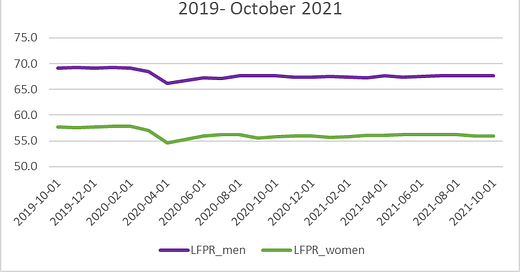A regional look at the Great Resignation
Squeezing what we can out of the Inland Empire's Current Population Survey microdata
My article earlier this week was about the Great Resignation – people quitting their jobs for better ones, or just completely leaving work. People are quitting their jobs at historically high rates – even in California.
There has also been a downward trend in labor force participation rates, meaning a decline in people employed or actively looking for work. Prior to the pandemic, the prime-age labor force participation rate for all workers was around 83%. Today, it’s around 81.5%. Even this small difference translates into millions of workers who have yet to re-join the labor market.
For example, this report from the National Women’s Law Center found that in September 2021, men gained about 220,000 jobs while women lost 26,000, compared to August 2021. Also, women’s (aged 20 and older) labor force participation rate dropped from 57.4% in August to 57.1% in September. This drop equates to 309,000 women exiting the labor force in just that month alone – and millions who have dropped out of the labor force since the start of the pandemic. The table below is from the Bureau of Labor Statistics’ Current Population Survey.
Data on labor force participation by sex comes from the Current Population Survey (CPS). While sample sizes for the CPS are quite small for the Inland Empire, I can use all the sample observations in 2021 and compare them to all of the ones from 2019 and the first two months of 2020, to generate a rough estimate of how labor force participation rates changed pre- and post-pandemic for male and female workers.
I’ve already reported that labor force numbers are picking up out here – but it’s possible that, like the rest of the country, this recovery has not been shared equally.
I calculate that women’s labor force participation in the region dropped from 50.8% (average) before the pandemic to 49.8% (average) during the pandemic, representing an exit of over 100,000 female workers from the labor force. This is a small decline compared to what we’re seeing nationally, but still a significant difference. While it’s hard to judge more recent patterns, this is strong evidence that we’re seeing similar patterns out here.



